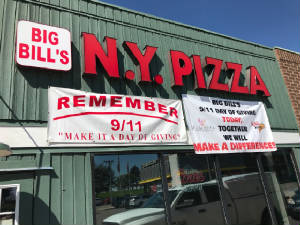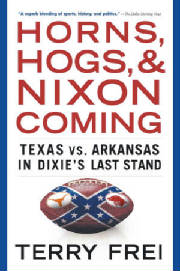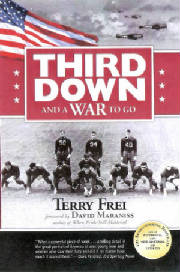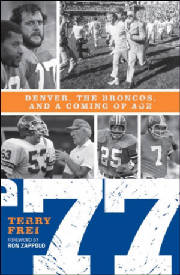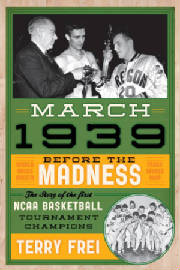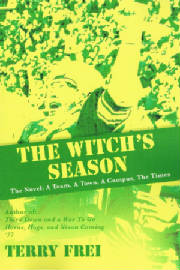October 2, 2024
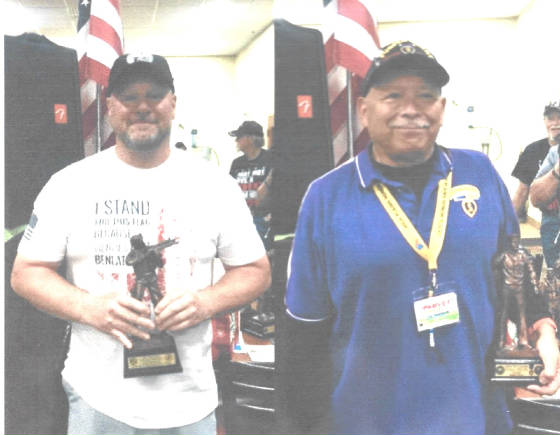
Matt Voris, president
of Northern Colorado's High Plains Honor Flight,
left, and Navy vet Phil Guardado of Fort Collins.
In the tiny compartment beneath the USS Higbee's rear gun mount, Phil Guardado was on fire and
burning. The repugnant sights, sounds and stench of war were all around him.
It was April 19, 1972.
The Higbee, a Gearing-class
destroyer, had just become the first American warship to be bombed in the Vietnam War.
Piloting a Soviet-made MiG-17
fighter, Le Xuan Di of the North Vietnamese Air Force scored the only on-target hit of the atttack. The 500-pound bomb slammed
into and destroyed the Higbee's rear gun mount.
Mostly because of the stored powder, fuel and ammunition, the
conflagration was immediate and horrific. Guardado and three other Navy men at their stations under the gun mount frantically
tried to escape the inferno.
Guardado emerged with gruesome shrapnel wounds and burns over about 60 percent of his
body.
But
he made it.
Fifty-two years later, Guardado, now 72, is fighting the demons of PTSD. He has lived in Fort Collins, just west
of Horsetooth Reservoir, for 41 years. He was gratified and emotional when he was part of a High Plains Honor Flight trip in 2023, and he since has been a goodwill ambassador for the organization.
That Ault-based non-profit raises money and escorts veterans on a charter flight to Washington D.C. to tour war memorials,
including the Vietnam War Memorial.
The trip is free for the vets.
Guardado recommends the
Honor Flight experience to any veteran.
Here -- as in, this story -- he will serve as a representative.
Of America's
Vietnam War vets.
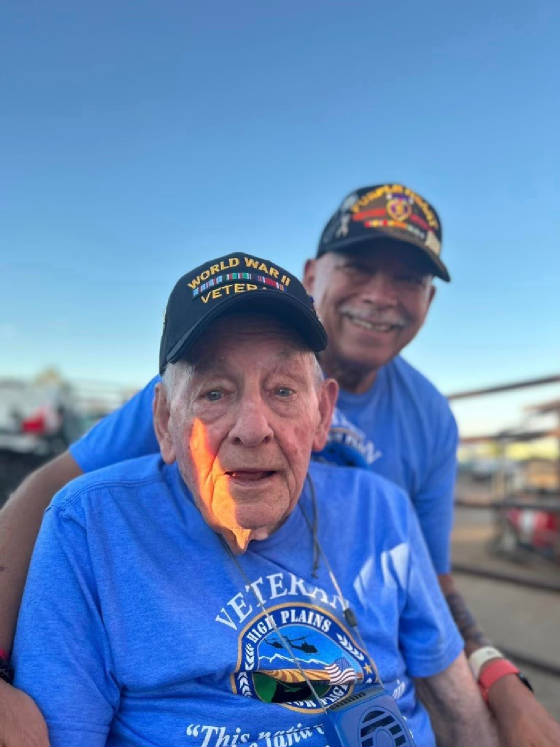
Phil Guardado, right, on High Plains Honor Flight
trip with 100-year-old WWII vet Algie Boone. "He's my hero," said Guardado. "I love that man."
* * *
As a kid in Azusa, California, Felipe "Phil" Guardado went to the City Park
pool to take swimmming lessons. Everyone in the area called the pool "The Plunge." There when he was 7, Phil met
6-year-old Linda Anderson, who later would be his wife for nearly 50 years, until she passed away in late 2022.
Linda and Phil were childhood sweethearts. And adult sweethearts.
Shortly after his
graduation from Azusa High, Phil enlisted in the Navy in June 1970.
His Selective Service draft lottery number was 2.
Just 2.
"I decided, 'I'm
going to join the Navy. They don't shoot at you,'" Phil said. "Seriously, that's why I joined the Navy. 'They don't
shoot at ships and I can see the world. And hopefully, other than Vietnam.'"
After boot camp at the San Diego
Naval Training Center, Guardado was assigned to the USS Firm, an Aggressive-class minesweeper. It was home-ported
in Long Beach.
"An analogy is that John Wayne's yacht was an ocean-going minesweeper that he converted," Guardado said.
"It was all made of wood. We're throwing nets and buoy finders and we would tow them behind the ship."
He was among a crew
of 88, including six officers. John Bonds was the captain. During the Firm's training trips back and forth from Long
Beach to San Francisco, Guardado was losing his lunch. And breakfast and dinner, too.
"You put a ship like that
out on the ocean, and it's like you're a leaf, you feel every little wave," he said. "I would always get seasick
as soon as they released the lines between the ship and the pier. The rocking and rolling, boy, would I get sick. I was sick
the whole time I was on that ship. "
His transfer to the Higbee wasn't complicated.
"She was home-ported in
Long Beach, too," he said. "So I'm getting off the minesweeper and going across the pier and getting on the destroyer."
When Phil joined the
crew as a seaman apprentice, his older brother,
Michael Guardado, already was aboard the Higbee as a signalman.
"I was hoping to become a gunner's mate," Phil said. "I was a deckhand
working for my gunner's rate. It was the old, 'Mop the deck, strip, scrape and repaint.' We thought, 'Boy, the Navy
has a big contract with this paint company.' We were always taking it it off and putting it back on."
Much to Phil's relief,
he didn'get seasick on the much larger Higbee.
"It was like going from a rowboat to the Queen Mary," he said.
The Higbee,
commisioned in January 1945, was named in honor of Lenah Higbee, the superintendent of the Navy Nurse Corps in World War I. After
stops at Midway Island and the Philippines, the Higbee arrived in the Gulf of Tonkin. It was part of an eight-destroyer
task force.
Guardado's general quarters role
on the Higbee was to be under the rear gun mount, in the upper handling room below deck and to, if necessary, feed
ammunition to the gunners. Extra diesel fuel also was stored below them.
"We'd load up the powder and the shells and
put them in the elevator belt that goes up into top-side, into the gun mount," Guardado said. "The gun mount would
manually take them into the barrels to be shot. It was three other sailors and me in this little area, mayby 5 by 5, and it's
full of powder and projectiles."
On that day in 1972, it was about to become even more uncomfortable.
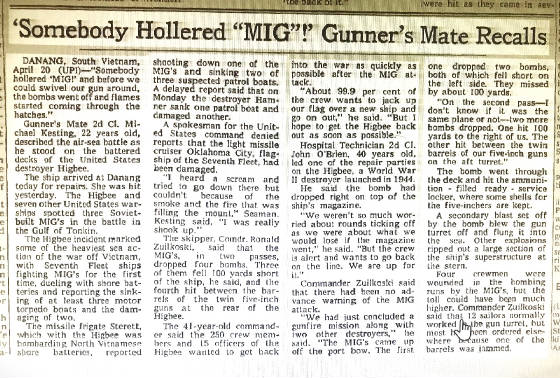
Page 16 of the April 21, 1972 New York Times
"We had just done a shore bombardment mission,"
Guardado said. "We were coming off the coast and heading back into deep waters, around the aircraft carrier Enterprise.
Well, at 3 o'clock in the afternoon, our ship was attacked by enemy aircraft."
The MiG fighters came from
the North Vietnamese Air Force's 923rd Fighter Regiment.
"As we were trying to get out to deep waters, MiGs were
attacking us and shooting, strafing," Guardado said. "They were also dropping bombs and I remember it as if it just
happened 10 minutes ago."
Guardado's shipmates told hm that three MiGs attacked the Higbee, and that's in line
with the immediate news accounts of the time. On the day after the attack, with the Higbee at nearby Danang for repairs,
The New York Times picked up a United Press International dispatch that sought to expain what happened.
The UPI reported
that three MiGs were spotted overhead in the battle. Later accounts and histories put the number of MiGs involved in the attack
on the Higbee at two. The second one also attacked a US cruiser, the USS Oklahoma City, being more
of a pest than a danger.
The Higbee captain, Commander Ronald Zuilkoski, was quoted extensively in the UPI
report.
"We had just concluded a gunfire mission along with two other destroyers," Zuilkoski said. "The
MiGs came up off the port bow. The first one dropped two bombs, both of which fell short on the left side. They missed by
about a hundred yards. On the second passs -- I don't know if it was the same plane or not -- two more bombs dropped. One
hit 100 yards to the right of us. The other hit between the twin barrels of our 5-inch guns on the aft turret."
That's where Guardado
was.
The
damage done by the 500-pound bomb from the MiG was immediate and immense, and the fires made it worse.
"When it hit
the deck, it pierced into the metal," Guardado said. "It slid across the back part of the ship and hit the center
post of the gun mount. It exploded. Now we were talking chaos. Fire. Everything. When I got up, all I could see was black
smoke and flames of fire from the phosphorous powder that was in those bottom canisters of the gun. That blew up.
"So all of that
is catching on fire. Of course, the four of us all got caught on fire and had other injuries. When I got up, all I could see
was the hole in the ship and black smoke rolling up to the sky. I knew I was hurt and the other three guys were hurt. You
could hear it in their pain and screaming."
Amid the chaos and pain, the four Navy men forced their way through a small hatch.
"Once we got
out, here comes the fire brigade and everybody coming to render help," Guardado said. "They had heard four sailors
were in there and expected the worst. Fatalities. Miraculously, there were no fatalities. If you see the picture of the gun
mount, and how it looked after the attack, the only thing you would ask is how many people got killed. And how in the hell
did you make it out alive?"
Indeed, this bears repeating: It was amazing that only four were injured on the Higbee in the
attack -- and no deaths. Zuilkoski explained to the UPI correspondent that usually there were 12 assigned to man the rear
turret gun itself, but they had been shifted because of a jammed barrel. Guardado said the gun misfired, causing it to jam,
and that neither he nor the other Navy men in the handling room were told the others above them had left.
Phil's brother, Michael, was on the signal bridge and saw the horror unfolding. He
knew his brother was in that area. And he worried.
I apologized for asking
Guardado about the extent of the shrapnel injuries and burns among the wounded.
"No, no, no," Guardado said. "It's
cathartic, my psychiatrist tells me. He says, 'Keep talking about it, it's helping you.'"
After a reflective pause, Guardado
said, "The others had fractures. I had shrapnel wounds. The three of us had second- and third-degree burns over 40 to
60 percent of our bodies. I was 60 percent burned."
Guardado first was treated in the Higbee's eating area, converted to be a
temporary field hospital..
"They shot us up with morphine," he said. "Then there was no pain, no pain at all."
Three of the four
sailors from the Higbee's rear gun mount area were grouped together and soon were shipped from hospital to
hospital.
Ultimately, Guardado settled in at the Balboa Naval Hospital in San Diego. He was there for 18 weeks. After being
released, he took two weeks of R&R and then reported back to duty on the Higbee. At the time, the destroyer was
in Long Beach, but was scheduled to begin the trip back to Vietnam two weeks later.
Soon, the reception in support of his return won over a conflicted Guardado.
"I was back with
my brothers," he said.
(One of his "brothers" was truly his brother, Michael, who would remain in the Navy
and have a 25-year service career.)
"All the officers knew me," Phil said. "They knew that I survived and
that if I have a hard time with the trauma, I can reach out to any of these guys and officers because they saw what I went
through."
He had gotten his promotion to seaman and the Higbee's holdover captain, Zuilkoski, reassured him.
Guardado rememers
the conversations going this way: '"You have paid your dues, son. And as long as I'm captain of this ship and you're
on this ship, you'll be up here on the bridge with me. You won't be standing any watches. This is just a nice, hopefully uneventful
trip to Vietnam."
Guardado liked all that.
'"As it turned out, I was the helmsman, the guy that actually drives the ship
with the wheel," Guardado said.
Soon, though, the Paris Peace Accords were signed on January 27, 1973, and they called for the
withdrawal of U.S. forces within 60 days.
The Higbee was part of the departure from Vietnam, and first went to Sydney.
Guardado's enlistment
was up and he left the Navy in 1974. When the captain asked him about re-enlisting, Guardado said, 'With all due respect,
sir ... Hell no.'" The captain laughed and said he understood.
Phil married Linda Anderson.
He also remembered that as he fought to
live while being treated on the Higbee, he had made a promise. "I said, 'Dear God, let me live,'" he said.
'Don't let anyone die. Let me live and I promise you, I will give back, somehow, some way. I will give back to humanity.'"
He earned a nursing
degree from Mount San Antonio College in Walnut, California and became a surgical nurse. He did that for 18 years at hospitals
in Ventura, Culver City and Hollywood. His PTSD got worse, though, and he stepped away from nursing.
"I could not deal with death
any longer," he said. "As a surgical nurse, you see a lot of that."
He went into corporate food services and was a manager and food service director
in Los Angeles. By then, he and Linda had a young son, Steven, and they decided they would rather raise him somewhere other
than Southern Californa. The family moved into the Fort Collins home where Phil still lives. He finshed up his food service
career in the Denver area, including in the Tech Center. Yes, that was a lof of driving back and forth, but compared to the
Southern California traffic, the I-25 commuting didn't seem that bad.
"I retired for about a month and I couldn't
stand being home alone because my wife was still working," Guardado said.
He became a part-time night auditor and
then assistant manager of a Loveland hotel and also worked at Target before retiring again.
Steven, now 40, is married,
has two children and lives in Loveland.
Phil at first was reluctant to visit the traveling Vietnam Memorial wall exhibit when
it came to Fort Colliins. Eventually, he did go, though.
"I kind of inched my way closer to the wall, very slowly,
until it really hit me hard," he said.
There, he met both retired U.S. Army Col. Stan Cass, who had served several tours in
Vietnam and was president of Honor Flight Northern Colorado; and HFNC board member Matt Voris.
Two months before Cass died in
April 2018, HFNC had announced the September trip would be its last. The reasons included that we had lost most World War
II veterans.
Voris soon oversaw a reboot, getting a thumbs up from Cass' widow, Cecily. Using the existing organization
legal framework and its 501(3)(c) non-profit status, Voris took over as president of the rechristened High Plains Honor Flight.
Its first trip to Washington was in 2019.
Voris essentially said Guardado had an open invitation to make an Honor Flight trip.
Linda urged Phil to go. "She was very ill, so I wasn't about to leave her," Phil said.
After Linda's death,
Voris asked again.
Phil said yes and was on the 2023 Honor Flight.
By then, Phil had discovered that one of the U.S. casualties
listed on the wall was his cousin, Raymond Guardado of Monrovia, California. "I was able to see his name on the wall
and they did a sketching of it for me," Phil said.
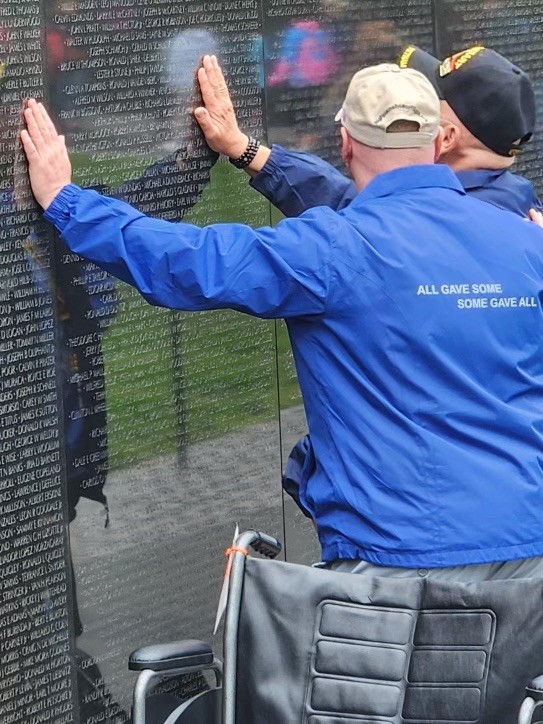
Matt Voris and Phil Guardado at the Vietnam Memorial
Wall, tracing the name of Phil's cousin, Raynond Guardado.
The trip affected Guardado more than he had expected.
"There are three memorable, gratifying experiences in
my life," he said. "Number 1 is my marriage to my beautiful wife. Linda was always there, a big advocate for me.
Truly my life partner. Number 2 is the birth of my son. Number 3 is going on the Honor Flight. It was so impactful on me.
I've always been a patriotic person ever since I can remember. And going to see my fallen brothers at the memorials in D.C.
was just incredible. It's kind of hard to put into words. It was life-changing for me in many ways.
"A lot of guys say, 'This
is now a closure for me in my journey of being a veteran.' For me, it just enlightens my journey as a veteran. There never
will be a closure for me." He said there wouldn' t be "as long as long as we're at war and we have brothers and
sisters that never made it home."
He said the Honor Flight experience doesn't end with the return from Washington.
"Honor Flight
has taken the veteran and has cared for them like no one has ever cared for them, other than immediate family," he said.
"They're supportive even after the trip. We don't know these people, we get to meet them a month before we go on this
trip that we have signed up for. . . You go on a High Plains Honor Flight, you now have a huge family that is now connected
to you that you never, ever dreamt about having. It's been nearly two years and my chaperone, Gena Spaur, still calls me."
For Vietnam-era veterans,
another issue is how they were treated by their nation, both at the time of their service and since. He recalled being in
uniform and being spit on as he got off a plane at LAX. "People were calling us baby killers," he said.
He agrees there has
been some increased respect with the passage of time, but not enough. Most notably, the U.S. military's use of the powerful
and toxic herbicide Agent Orange years ago in Vietnam still is a plague.
"Our country has not done any favors for the Vietnam veterans,"
he said. "I still feel probably 85 percent that way. They haven't done enough. Politicians in Washington say, 'Well you
know, even though you were exposed to Agent Orange, we have to wait and see if you die from it.' And a lot of us Vietnam veterans
feel that the Veterans Administration is just waiting for us to die off so they don't have to worry about paying us off. I've
lost six shipmates to Agent Orange.
"They're saying, 'How can you be exposed to Agent Orange?' When you get close to the shore,
and the ship is sucking up all that water, and residual from the foliants in the water, and sucked it up and you're supposed
to purify it to drink water, and we're bathing in it, brushing our teeth, and drinking it, cooking in it ... The doctors have
told me it's not a matter of if you're going to get it, it's when you're going to get it. It lays dormant for 50-plus years.
And now people are coming down with diabetes, and have already, Parkinson's, and just other ailments from Agent Orange. Yet
the government says, 'Well, we need more proof.'"
As
I'm typinig this story, Guardado is about to head to Dallas for the October 6-13 reunion of Higbee crew members.
It will be the first of those reunions he has attended. Honor Flight broke the ice, so to speak.
The next High Plains Honor Flight is scheduled for April 27, 2025.
This
from the son of a decorated P-38 pilot in World War II ...
If
you're eligible, go.
We owe you.





